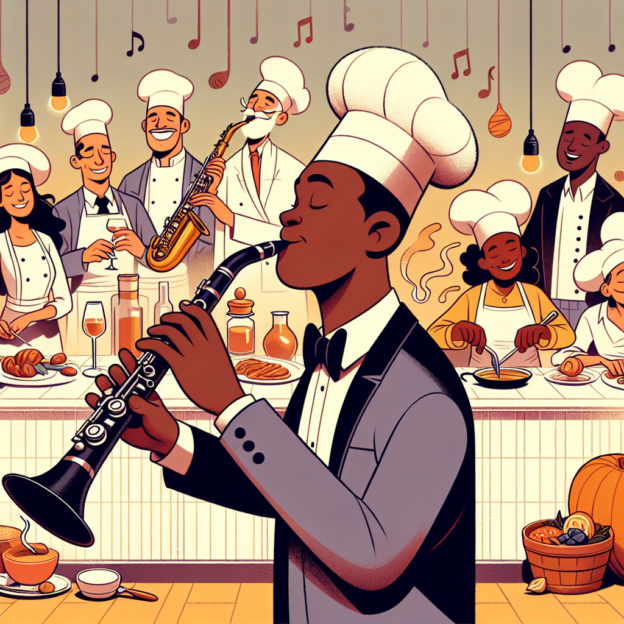The Harmony of Clarinet and Cuisine
The clarinet, often called the voice of jazz, has a lyrical quality that's as smooth as a silky hollandaise sauce. But have you ever thought about how this versatile instrument resonates with the artistry and flavors found in jazz-influenced cuisine? It's not just the music—it's the unspoken connection between melody and meal prep that binds these two creative worlds together.
Let's start with jazz itself—an improvised, free-flowing art form. Now, think about cooking a dish in the kitchen without recipes, working only with instinct and heart. Jazz musicians, including legendary clarinetists like Benny Goodman and Artie Shaw, create magic with their notes, just as chefs play with ingredients to concoct flavor symphonies. A single clarinet note, like the fresh zing from a ripe lemon zest, can be simple but transformative.
The Clarinet's Role in Jazz
Historically, the clarinet carved out its spot in jazz music's pantheon during the big band era. Its versatile timbre allowed it to either lead a melody or melt into the rhythm section like butter on a hot skillet. Much like a chef uses bold spices sparingly or zests citrus for a pop of flavor, the clarinet often adds understated brilliance to a jazz ensemble. You'll hear its warm, woody tone rise unexpectedly, like the surprise of chili heat in chocolate desserts. Picasso once said, ‘Jazz is the music of sorrow and joy,' and isn't that how food speaks to us too?
| Jazz Style | Culinary Equivalent |
|---|---|
| Dixieland | Spicy Jambalaya |
| Swing | Smooth Béchamel Sauce |
| Bebop | Complex Mole Sauce |
| Cool Jazz | Refreshing Ceviche |
Jazz-Influenced Cuisine
Jazz-influenced cuisines—soul food, Creole, or even a smoky barbecue—mirror the clarinet's personality. Imagine the clarinet's playful staccatos mimicked by caramelized BBQ ribs' complex layers, or the soulful swing of a well-cooked gumbo swaying to the rhythm section. These meals, like jazz and music itself, come from a place of roots and experimentation. Louisiana serves as cultural crossroads for both worlds—jazz music and hearty Creole cuisine, an interplay that defines the spirit of a melting pot.
The Art of Clarinet and Cooking
For professional clarinetists and even beginners learning the nuances of embouchure and breath control, there is relevance in the kitchen too. Letting flavors develop in a pot takes more than following steps; it requires that same patience a clarinetist finds while stretching to hit the highest note. To play a clarinet delicately yet powerfully mirrors the resilience it takes to slow-cook a stock to perfection.
While Martin Freres Clarinets are celebrated worldwide for their superior craftsmanship and rich tones, the ingenuity of blending sound and flavor crosses instruments and resonances universally. For instance, the clarinet's high-pitched joys pair well with vibrant dishes like jambalaya, its warm, melodic midrange simmering in earthy tones akin to a New Orleans gumbo's umami depth.
Musical and Culinary Parallels
Even advanced musicians find parallels in reducing solos to simple phrases, similar to reducing a sauce's richness until it highlights only the core flavor. The same way chefs garnish dishes at the very end for a perfect plate presentation, musical rests and measured breaths give space to enhance clarinet soundscapes. Jazz's improvisation tradition resembles visiting a farmer's market and crafting a dish on the fly, facilitating dynamic storytelling through continuity—or bursts of surprise.
“Cooking is like jazz—it's improvisation on themes. You take a standard dish and riff on it. You have to know the basics to cook, just as you have to know the basics to play jazz.”
Amateur Experiences in Music and Cooking
What happens when amateurs attempt clarinet playing or untrained cooks whip up a Creole feast? Sometimes, you strike gold! However, there's always room for improvement. Clarinets, much like cookware, require care. Proper cleaning for clarinets matters as much to musicians as seasoning your cast iron does for passionate cooks. Brushed keys glimmer akin to how sautéed onions sparkle before softening in stockpots.
Finding Culinary Inspiration in Music
If you're a clarinet player, think of jazz-influenced cuisine next time you explore your favorite music albums or live sets. What does the piece you're playing remind you of flavor-wise—a crisp Pinot Blanc or tangy étouffée? Every style of jazz, from Dixieland's blistering pace to bebop grooves, offers food-thought combinations.
The Journey of Learning Clarinet
Learning the clarinet requires agility—sliding smoothly through its registers parallels the stirring olfactory shifts as garlic hits a pan of hot oil. There's joy in observing these transitions. Whether partnering up with musicians accompanying a lively dinner gig or playing solo reminiscent of culinary alchemy unfolding alone in the kitchen, music and food unify through passion.
Clarinetists as Culinary Artists
Have you ever heard tales of clarinetists who double as culinary artists? It's not uncommon. The creativity poured into crafting melodies naturally spills over into recipe experimentation. Just like controlling fingering techniques on a Martin Freres Clarinet demands adaptiveness, creating flawless roux or soufflé requires shifts in technique and mood.
Conclusion
For hobbyists and pros alike, these clear connections between music and gastronomy offer an imaginative way to widen appreciation beyond one medium into another. Next time your fingers dance over clarinet keys, consider your culinary skills too. What improvisational ‘recipe,' musical or edible, awaits unfolding under your hands?







